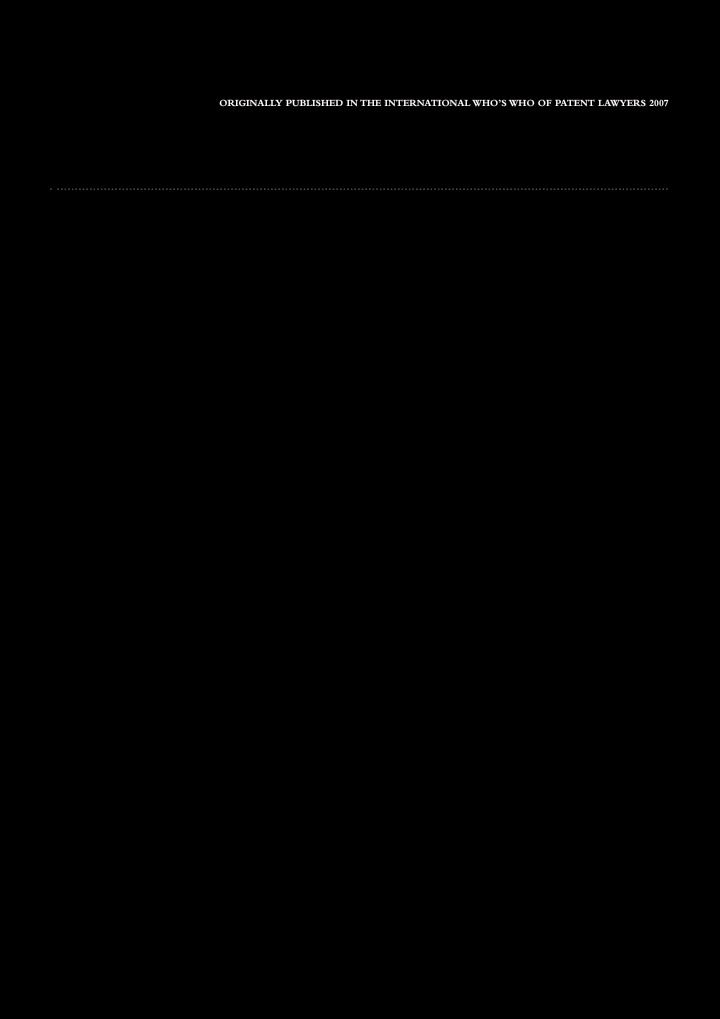



www.whoswholegal.com REPORT ORIGINALLY PUBLISHED IN THE INTERNATIONAL WHO’S WHO OF PATENT LAWYERS 2007 THE CHANGING GLOBAL LANDSCAPE REQUIRES FLEXIBILITY AND CREATIVITY IN UNITED STATES PATENT ENFORCEMENT Kenneth R Adamo, David M Maiorana and Susan M Gerber, Jones Day The US patent system is one component Ink (lack of per se market power in patent); evidences the Court’s recognition of the in the exploitation and enforcement of eBay v Merc Exchange (availability of need for clarity to guide the exploitation and intellectual property rights. The US cannot permanent injunctive relief); and enforcement of US patent rights. be viewed in isolation from the rest of world, Unitherm Food Sys Inc v Swift-Eckrich Inc however. When it comes to intellectual (requirement to move for new trial or IN TODAY’S PATENT LA W CLIMATE, PAT - property in today’s global economy, more judgment as a matter of law to preserve right ENTEES MUST THINK GLOBALLY AND and more US patentees seek and obtain to appellate review). FLEXIBLY WHEN ENFORCING THEIR foreign counterpart patents to protect their In the current term, the Court has UNITED STATES PATENT RIGHTS ideas. The effectiveness of both foreign and accepted three additional patent cases. Patentees must think globally and flexibly domestic patent systems, therefore, can have In MedImmune Inc v Genentech Inc the when enforcing their US patent rights. a great impact on the value and enforcement Court decided that the actual controversy When enforcing US patents, the days of of US patents. requirement of the Declaratory Judgment filing a patent infringement complaint in Act does not require a patent licensee to a district court and waiting three or more years for the inevitable permanent injunction THE US SUPREME COURT HAS TAKEN A are over. By the time some district court KEEN INTEREST IN THE US WHEN IT COMES cases reach resolution, the technology at PATENT SYSTEM The US Supreme Court (the Court), issue may be obsolete. Further, the Court TO INTELLECTUAL apparently recognising the importance of recently eliminated the so-called “automatic” clear application of the patent laws in the injunction in its eBay decision. Alternatives PROPERTY IN TODAY’S US, has taken up patent case review with to the traditional US patent enforcement increasing frequency in recent years. The route have evolved to avoid these drawbacks. GLOBAL ECONOMY, US Court of Appeals for the Federal Circuit For international companies, especially those (Federal Circuit), was created to provide who file for counterparts to their US patents, MORE AND MORE US that clarity; when it has become obvious worldwide enforcement of their patent that the judges of the Federal Circuit were portfolios and avoiding piecemeal litigation is PATENTEES SEEK AND irreconcilably divided on key issues, the becoming more important. The legal systems, Court has stepped in to resolve them. both domestically and internationally, have OBTAIN FOREIGN For example, in Markman , the Court responded to the changing times and more unanimously put the issue of claim changes are not far out on the horizon. COUNTERPART construction to rest, holding that claim construction is a matter of law for the judge Owners of US patents should always consider PATENTS TO PROTECT (and not the jury) to decide. At about the the US International Trade Commission when same time, the Court reversed the Federal contemplating patent enforcement THEIR IDEAS Circuit’s en banc Hilton Davis decision, Although it is not a new forum, the US affirming the continued viability of the International Trade Commission (ITC) doctrine of equivalents and defining the can provide a very fast remedy for patent parameters for applying the doctrine. Just refuse to pay royalties and breach the license infringement, including an order excluding five years later, in Festo , the Court again took agreement before bringing a declaratory the infringing products from entering up the issue of the doctrine of equivalents, judgment action. In KSR International Co v the US. Under section 337 of the Tariff holding that narrowing amendments made Teleflex Inc the Court will consider whether Act of 1930 (section 337), a company that for a substantial reason related to patentability an alleged invention satisfies the statutory imports goods into the US, or sells goods for give rise to a rebuttable presumption that requisite of non-obviousness when the prior importation, can be named as a respondent prosecution history estoppel bars application art discloses the separate components of the in an ITC investigation. The ITC makes of the doctrine. patented combination. Most recently, the its violation determinations under section The Court has stepped up its review of Court took up the case of Microsoft v AT&T , 337 at the “earliest practicable time”, which patent cases even more since 2002. Just this to consider whether 35 USC section 271(f) typically means 12 to 14 months from past term, the Court handed down three reaches activity occurring outside the US. institution of the investigation. In addition, decisions in patent cases: ITW v Independent This close marking of patent issues because jurisdiction is in rem (deriving from E DITORIAL POLICY AND SELECTION CRITERIA : N OMINEES HAVE BEEN SELECTED BASED UPON COMPREHENSIVE , INDEPENDENT SURVEY WORK WITH BOTH GENERAL COUNSEL AND PATENT LAWYERS IN PRIVATE PRACTICE WORLDWIDE . O NLY SPECIALISTS WHO HAVE MET INDEPENDENT INTERNATIONAL RESEARCH CRITERIA ARE LISTED .
Recommend
More recommend